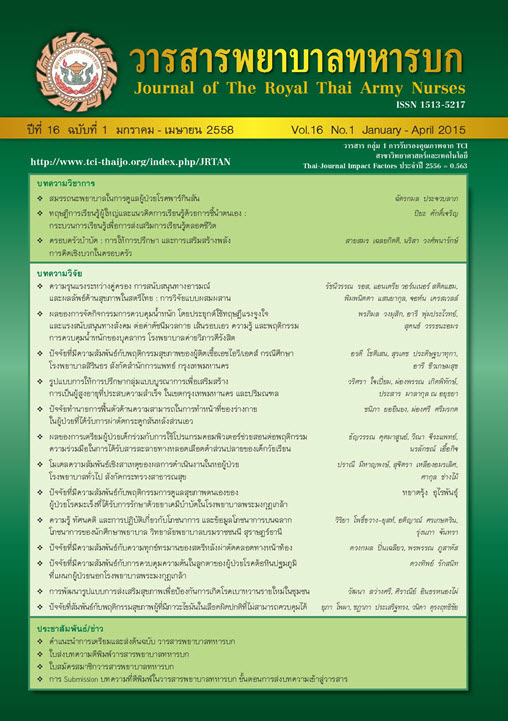โมเดลความสัมพันธ์เชิงสาเหตุของผลการดำเนินงานในหอผู้ป่วยโรงพยาบาลทั่วไปสังกัดกระทรวงสาธารณสุข A Causal Model of Patient Unit Performance in General Hospital under Ministry of Public Health
Keywords:
ผลการดำเนินงานในหอผู้ป่วย, ภาวะผู้นำ, การจัดการความรู้, ความยึดมั่นผูกพันต่อองค์กร, หัวหน้าหอผู้ป่วย, patient unit performance, leadership, knowledge management, organizational commitment, head nurseAbstract
การวิจัยครั้งนี้มีวัตถุประสงค์เพื่อกำหนดและทดสอบโมเดลความสัมพันธ์เชิงสาเหตุของผลการดำเนินงานในหอผู้ป่วยโรงพยาบาลทั่วไป สังกัดกระทรวงสาธารณสุขกรอบแนวคิดการวิจัยครั้งนี้สังเคราะห์จากงานวิจัยและแนวคิดภาวะผู้นำของแบส (Bass, 1985) การจัดการความรู้ของโกลด์ และคณะ (Gold et al, 2001) ความยึดมั่นผูกพันต่อองค์กรของเมเยอร์อลัน และสมิทธ์ (Meyer, Allen & Smith, 1993) และผลการดำเนินงานของหอผู้ป่วยตามเกณฑ์ของรางวัลคุณภาพแห่งชาติมัลคอล์มบอลดริจ (The Malcolm Baldrige National Quality Award for Health Care, 2009-2010) เพื่อสร้างโมเดลความสัมพันธ์เชิงสาเหตุ ระหว่างชุดตัวแปรที่ประกอบด้วยภาวะผู้นำ การจัดการความรู้ ความยึดมั่นผูกพันต่อองค์กรและผลการดำเนินงานของหอผู้ป่วยซึ่งแสดงความสัมพันธ์ และอิทธิพลของตัวแปร 4 ตัวดังกล่าว กลุ่มตัวอย่าง คือ หัวหน้าหอผู้ป่วยที่ปฏิบัติงานที่หอผู้ป่วยใน โรงพยาบาลทั่วไป สังกัดกระทรวงสาธารณสุข จำนวน 69 แห่ง จำนวน 322 คน ผู้วิจัยส่งแบบสอบถามให้กับหัวหน้าหอผู้ป่วย และหัวหน้าหอผู้ป่วยตอบแบบสอบถามกลับมาจำนวน 293 คน คิดเป็นร้อยละ 90.99 และข้อมูลที่สามารถนำมาวิเคราะห์ จำนวน 285 คน คิดเป็นร้อยละ 88.50 เครื่องมือวิจัย ได้แก่ แบบบันทึกข้อมูลส่วนบุคคล แบบสอบถามภาวะผู้นำ แบบสอบถามการจัดการความรู้ แบบสอบถามความยึดมั่นผูกพันต่อองค์กรและแบบสอบถามผลการดำเนินงานขององค์กร ซึ่งได้รับการตรวจสอบความตรงตามเนื้อหา โดยผู้เชี่ยวชาญและเจ้าของเครื่องมือ และมีค่าความเชื่อมั่นเท่ากับ .83 .94 .71 และ .80 ตามลำดับ วิเคราะห์ข้อมูลโดยใช้ โปรแกรมสำเร็จรูป ข้อค้นพบจากการศึกษา พบว่าภาวะผู้นำและการจัดการความรู้มีอิทธิพลทางตรงกับผลการดำเนินงานในหอผู้ป่วย
(β = .24, β = .40, p< .001) ภาวะผู้นำมีอิทธิพลทางตรงกับการจัดการความรู้ (β = .67, p< .001) และความยึดมั่นผูกพันต่อองค์กร (β = .56, p< .001) ภาวะผู้นำยังมีอิทธิพลทางอ้อมกับผลการดำเนินงานในหอผู้ป่วยหากมีการจัดการความรู้ (β = .27, p< .001) โมเดลเชิงสาเหตุของผลการดำเนินงานในหอผู้ป่วยมีความสอดคล้องกับข้อมูลเชิงประจักษ์ (Chi-square = 38.230, df = 28, Probability level = 0.094, CMIN/DF = 1.365, GFI = 0.975, AGFI = 0.951, RMSEA = 0.036) และโมเดลดังกล่าว สามารถอธิบายความแปรปรวนของผลการดำเนินงานในหอผู้ป่วยได้ร้อยละ 35 จากข้อค้นพบของการวิจัยครั้งนี้ทำให้เกิดองค์ความรู้ทางการบริหารการพยาบาลที่สำคัญในการพัฒนาผลการดำเนินงาน ของหอผู้ป่วยโรงพยาบาลทั่วไป สังกัดกระทรวงสาธารณสุข โดยผู้บริหารควรให้ความสำคัญและสนับสนุนให้มี การพัฒนาภาวะผู้นำ ทั้งแบบภาวะผู้นำการปฏิบัติ และภาวะผู้นำการเปลี่ยนแปลงให้กับหัวหน้าหอผู้ป่วย เนื่องจากภาวะผู้นำของหัวหน้าหอผู้ป่วยมีอิทธิพลและมีบทบาทสำคัญที่สุดต่อผลการดำเนินงานในหอผู้ป่วย โดยภาวะผู้นำของหัวหน้าหอผู้ป่วยส่งผลให้เกิดความยึดมั่นผูกพัน ต่อองค์กร รวมทั้งทำให้การจัดการความรู้ในหอผู้ป่วยเป็นไปอย่างมีประสิทธิภาพ ซึ่งการจัดการความรู้ในหอผู้ป่วยจะทำให้เกิดการพัฒนาผลการดำเนินงานในหอผู้ป่วยให้ดียิ่งขึ้น ข้อเสนอแนะกลยุทธ์การพัฒนาผลการดำเนินงานในหอผู้ป่วยนั้นต้องส่งเสริมและพัฒนาให้หัวหน้าหอผู้ป่วยมีภาวะผู้นำและมีการจัดการความรู้ในองค์กร
The purposes of this cross-sectional descriptive study were to identify and test a causal model of Patient Unit Performance. Bass, s Leadership Theory (1985); Gold et al, s Knowledge Management concept (2001); Meyer, Allen & Smith, s organizational commitment (1993), andThe Malcolm Baldrige National Quality Award Criteria for Health Care (2009-2010) have provided a guide for the conceptual framework of this study which illustrated the causal relationship among four variables as leadership, knowledge management, organizational commitment and patient unit performance. Samples were 322 head nurses at sixty nine General hospitals in Thailand. The research study was conducted by sending surveys questionnaires to 322 head nurses and ninety three out of 322 (90.90%) of the eligible candidates responded to the survey but only 285 (88.50%) were able to be calculated by statistic. They were asked to answer five sets of questionnaires: 1) Personal Data Form, 2) Multifactor Leadership Questionnaire, 3) Knowledge Management Questionnaire, 4) Organizational Commitment Questionnaire, and 5) Patient Unit Performance Questionnaire. Validity of the
instruments was confirmed by experts reviewed and owner research. Using Cronbach’s alpha criteria, reliability of the questionnaire were .83 for the Multifactor Leadership Questionnaire, .94 for the Knowledge Management Questionnaire, .71 for the Organizational Commitment Questionnaire, and .80 for patient unit performance. Data were analyzed by using the statistical programs for personal computer. The findings of this study revealed that leadership of head nurse and knowledge management had positive direct effects on Patient Unit Performance (β = .24, β = .40, p< .001). Leadership had a positive direct effect on knowledge management (β = .67, p< .001) and organizational commitment (β = .56, p< .001). Leadership also had an indirect effect on patient unit performance through knowledge management (β = .27, p < .001). The causal model of Patient Unit Performance was congruent with the empirical data (Chi-square = 38.230, df = 28, Probability level = 0.094, CMIN/DF = 1.365, GFI = 0.975, AGFI = 0.951, RMSEA = 0.036). The model accounted for 35% of the variance in patient unit performance and a substantial proportion of the variance of the mediating variables.
The findings of this research importantly develop a new nursing management knowledge to enhance the Patient Unit Performance in General Hospital under Ministry of Public Health. The nursing administrator should focus and encourage the leadership of head nurse both transactional and transformational leadership since head nurse’s leadership had a positive direct effect on Patient Unit Performance, organizational commitment, and knowledge management. In addition, the knowledge management had an effect to improve Patient Unit Performance.
Downloads
Downloads
How to Cite
Issue
Section
License
บทความหรือข้อคิดเห็นใดใดที่ปรากฏในวารสารพยาบาลทหารบกเป็นวรรณกรรมของผู้เขียน ซึ่งบรรณาธิการหรือสมาคมพยาบาลทหารบก ไม่จำเป็นต้องเห็นด้วย
บทความที่ได้รับการตีพิมพ์เป็นลิขสิทธิ์ของวารสารพยาบาลทหารบก
The ideas and opinions expressed in the Journal of The Royal Thai Army Nurses are those of the authors and not necessarily those
of the editor or Royal Thai Army Nurses Association.






